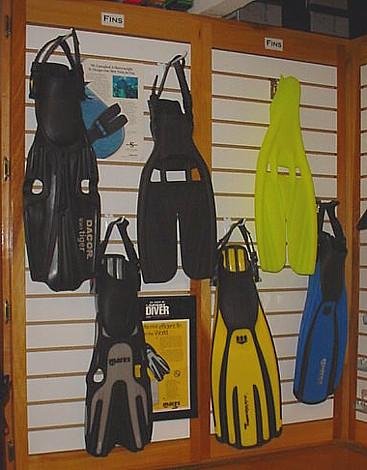Fins
The ability to move efficiently in the water is essential to the safety and enjoyment of scuba diving. With all the gear required for scuba diving, even the strongest swimmers would find it difficult to swim using only their arms and feet.
To make swimming easier, you'll wear fins to increase the surface area of your feet. This allows you to use the powerful muscles in your legs to propel you through the water.

Fin Styles
Fins are available in two basic styles: heel strap and full foot. Full foot fins have a soft pocket that fits your bare foot, while heel strap fins are open at the rear and have an adjustable heel strap.
Most heel strap fins are designed to be worn with booties, so they are the required style if you plan on diving in cold water. And since wearing booties is even beneficial in warm water, heel strap fins can be used in tropical waters as well. For this reason, heel strap fins provide the most versatility, and are the best choice for divers.


Fin Features & Components





Fins have undergone many innovations. Early fins were made of stiff rubber, while most modern fins are extremely flexible.
Although fin design varies by manufacturer, there are some common features and components that most have in common.
- Blade
- A fin's blade is the flat surface that extends from the foot pocket. Blades vary in length, width, and flexibility. Most divers prefer a flexible blade that reduces strain on the leg.
- Strap
- All heel-strap fins include a strap at the rear of the foot pocket. Many fins feature a quick release buckle at each end of the strap to make donning the fins easier.
- Rails
- Rails border the sides of the fin and add rigidity to the blade. They also help trap water over the blade to increase efficiency.
- Channels
- Many fins include channels that direct water along the length of the fin. Channels can be as simple as a vein that protrudes from the fin surface, or as sophisticated as a flexible rubber groove that also allows the fin to cup the water over the blade.
Selecting The Correct Size Fins
Fins are available in a variety of sizes, so try them on for fit and comfort before committing to a purchase. A fin that's too loose will wobble or fall off, cramp your leg, or cause fatigue. A tight fin will be uncomfortable and blister your foot.
Most heel strap fins are designed to be worn with booties. It's impossible to judge their fit with bare feet, so bring your booties with you when shopping for fins.

Rinsing Your Fins
Your gear will be exposed to salt, sand, and organic matter. It's important to rinse your gear with fresh water to remove these materials. Even if the gear appears to be clean, salt crystals form when the gear dries, and this dries out soft materials such as silicone and rubber.
You should rinse your gear with fresh water at the end of every diving day. And since rinsing does not remove every salt crystal that forms, soak the gear overnight in fresh water before long-term storage.

Storing Your Fins
Heat, humidity, ozone, and ultraviolet rays are part of any dive day. But over time, these can harm the rubber and silicone your skin gear is made of.
To prevent these elements from damaging your skin gear, store it in a cool, dark, and dry place. If your mask came with a storage case, use it to protect the mask's skirt. Hang your fins or lay them flat to prevent warping. Allow the gear to dry completely before storage to prevent mildew from forming.
Storage between dives is equally important. Gear should be kept as clean as possible, and away from direct sunlight. A short period in the sun can soften the gear and cause permanent deformation. For example, leaning your fins up against a wall exposed to direct sunlight could permanently warp them.
Inspecting Fins
Mask straps, fins straps, and snorkel keepers undergo a lot of stress and stretching. Over time they weaken and may break.
Be sure to inspect your straps for signs of weakness before every dive trip. Replacements are readily available, and are included in most "save-a-dive" kits. It's best to discover a potential failure before you find yourself on a boat with broken straps and no replacements.
